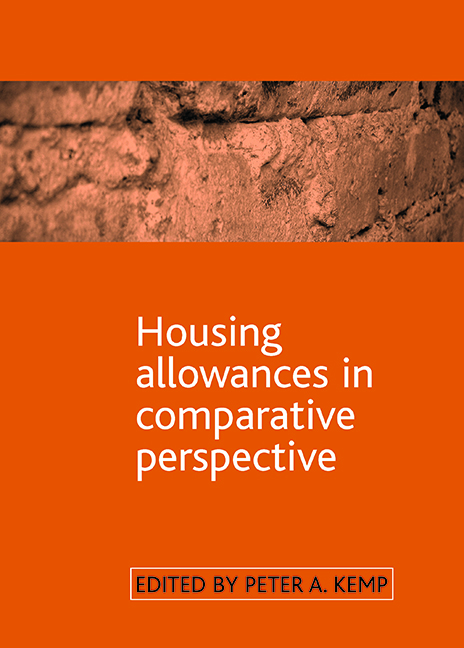Book contents
- Frontmatter
- Contents
- List of tables and figures
- Acknowledgements
- Notes on contributors
- one Housing allowances in context
- two Housing allowances and the restructuring of the Australian welfare state
- three The New Zealand experience of housing allowances
- four Canadian housing allowances
- five Housing allowances American style: the Housing Choice Voucher programme
- six Housing Benefit in Britain: a troubled history and uncertain future
- seven Housing allowances in France
- eight Housing allowances in Germany
- nine Housing allowances in the Netherlands: the struggle for budgetary controllability
- ten Housing allowance systems in Sweden
- eleven Housing allowances in the Czech Republic in comparative perspective
- twelve Housing allowances in the advanced welfare states
- Index
one - Housing allowances in context
Published online by Cambridge University Press: 15 September 2022
- Frontmatter
- Contents
- List of tables and figures
- Acknowledgements
- Notes on contributors
- one Housing allowances in context
- two Housing allowances and the restructuring of the Australian welfare state
- three The New Zealand experience of housing allowances
- four Canadian housing allowances
- five Housing allowances American style: the Housing Choice Voucher programme
- six Housing Benefit in Britain: a troubled history and uncertain future
- seven Housing allowances in France
- eight Housing allowances in Germany
- nine Housing allowances in the Netherlands: the struggle for budgetary controllability
- ten Housing allowance systems in Sweden
- eleven Housing allowances in the Czech Republic in comparative perspective
- twelve Housing allowances in the advanced welfare states
- Index
Summary
Introduction
Most of the advanced welfare states are committed to ensuring that housing is affordable to ordinary citizens. Shelter is not only a necessity, but for most households it is also the largest single item in their budget. For low-income households in particular, the ratio of housing expenditure to income can be high. In fact, most of the advanced welfare states provide, in one form or another, assistance with housing expenditure. Although the aims and instruments employed vary from one country to another, a common concern is to ensure that ordinary people can afford to occupy decent housing at a price within their means.
The policy instruments that governments employ to ensure this basic goal vary between countries and over time (Doling, 1997). Governments can seek to provide assistance on the supply side, that is, to builders, landlords and financiers. Typically, supply-side assistance is geared towards lowering the price or rent that households have to pay for their housing. This may be achieved through the provision of direct subsidies to builders or landlords, such as low interest loans or capital grants, which are often referred to as ‘bricks-and-mortar’ subsidies (Oxley, 1987). It may also be achieved by indirect subsidies such as tax relief to private landlords. Whether by these direct or indirect means, supply-side subsidies to providers make it possible for them to charge less than the market price or the economic cost of the dwelling. It may also take the form of price regulation, such as rent controls, that limit the amount that landlords or other suppliers of accommodation may charge to consumers (Robinson, 1979).
Governments may also provide assistance to the demand side, that is, directly to the consumers (home buyers and renters), thereby helping to ensure that they can afford to pay the price or rent charged for their dwelling. Demand-side assistance can take a number of forms, including both direct subsidies such as low interest loans for home buyers, and indirect assistance such as mortgage interest tax relief. However, perhaps the most common form of demand-side assistance is housing allowances. These are income-related subsidies tied to housing that are paid to consumers (or directly to landlords on their behalf).
- Type
- Chapter
- Information
- Housing Allowances in Comparative Perspective , pp. 1 - 16Publisher: Bristol University PressPrint publication year: 2007
- 1
- Cited by

